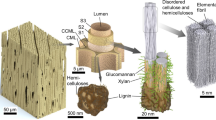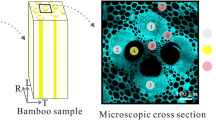Abstract
The awn in stork’s bill (Erodium gruinum) seed dispersal units coils as it dries. This hygroscopic movement promotes the dissemination and sowing of the seeds. Here we aimed to understand the movement rate, by correlating water dynamics within the awn to the spatial variation in the chemical composition of the awn’s cell walls. We followed the hygroscopic movement visually and measured the kinetics of water adsorption–desorption in segments along the awn. We integrated data from white light, fluorescence, and Raman microscopy, and Matrix Assisted Laser Desorption Ionization imaging to characterize the micro chemical makeup of the awn. We hydrolyzed awns and followed the change in the cell walls’ composition and the effect on the movement. We found that the coil’s top segment is more sensitive to humidity changes than the coil’s base. At the top part of the coil, we found high concentration of modified lignin. In comparison, the base part of the awn contained lower concentration of mostly unmodified lignin. Ferulic acid concentration increased along the awn, apparently cross-linking hemicellulose and strengthening cell-to-cell adhesion. We propose that the high concentration of modified lignin at the coil’s top increased the hydrophobicity of the cell walls, allowed faster water molecules dynamics; thus inducing fast reaction to ambient humidity. Strong cell-to-cell adhesion in this region created a durable tissue required for the awn’s repeated movement that is induced by the diurnal humidity cycles.
Graphical Abstract














Similar content being viewed by others
References
Abidi N, Hequet E, Cabrales L et al (2008) Evaluating cell wall structure and composition of developing cotton fibers using Fourier transform infrared spectroscopy and thermogravimetric analysis. J Appl Polym Sci 107:476–486. https://doi.org/10.1002/app.27100
Abraham Y, Elbaum R (2013) Hygroscopic movements in Geraniaceae: the structural variations that are responsible for coiling or bending. New Phytol 199:584–594. https://doi.org/10.1111/nph.12254
Abraham Y, Tamburu C, Klein E et al (2012) Tilted cellulose arrangement as a novel mechanism for hygroscopic coiling in the stork’s bill awn. J R Soc Interface 9:640–647. https://doi.org/10.1098/rsif.2011.0395
Agarwal UP, Atalla RH (1986) In-situ Raman microprobe studies of plant cell walls: macromolecular organization and compositional variability in the secondary wall of Picea mariana (Mill.) B.S.P. Planta 169:325–332. https://doi.org/10.1007/BF00392127
Agarwal UP, Ralph SA (1997) FT-Raman spectroscopy of wood: identifying contributions of lignin and carbohydrate polymers in the spectrum of black spruce (Picea mariana). Appl Spectrosc: AS 51:1648–1655
Boerjan W, Ralph J, Baucher M (2003) Lignin biosynthesis. Annu Rev Plant Biol 54:519–546. https://doi.org/10.1146/annurev.arplant.54.031902.134938
Chabannes M, Barakate A, Lapierre C et al (2001) Strong decrease in lignin content without significant alteration of plant development is induced by simultaneous down-regulation of cinnamoyl CoA reductase (CCR) and cinnamyl alcohol dehydrogenase (CAD) in tobacco plants. Plant J 28:257–270. https://doi.org/10.1046/j.1365-313X.2001.01140.x
Edwards HGM, Farwell DW, Webster D (1997) FT Raman microscopy of untreated natural plant fibres. Spectrochim Acta Part A Mol Biomol Spectrosc 53:2383–2392. https://doi.org/10.1016/S1386-1425(97)00178-9
Elbaum R, Abraham Y (2014) Insights into the microstructures of hygroscopic movement in plant seed dispersal. Plant Sci 223:124–133. https://doi.org/10.1016/j.plantsci.2014.03.014
Evangelista D, Hotton S, Dumais J (2011) The mechanics of explosive dispersal and self-burial in the seeds of the filaree, Erodium cicutarium (Geraniaceae). J Exp Biol 214:521–529. https://doi.org/10.1242/jeb.050567
Fry SC (1986) Cross-linking of matrix polymers in the growing cell walls of angiosperms. Annu Rev Plant Physiol 37:165–186. https://doi.org/10.1146/annurev.pp.37.060186.001121
Gierlinger N, Luss S, König C et al (2010) Cellulose microfibril orientation of Picea abies and its variability at the micron-level determined by Raman imaging. J Exp Bot 61:587–595. https://doi.org/10.1093/jxb/erp325
Gierlinger N, Keplinger T, Harrington M (2012) Imaging of plant cell walls by confocal Raman microscopy. Nat Protoc 7:1694–1708. https://doi.org/10.1038/nprot.2012.092
Harris PJ, Hartley RD (1976) Detection of bound ferulic acid in cell walls of the Gramineae by ultraviolet fluorescence microscopy. Nature 259:508–510. https://doi.org/10.1038/259508a0
Himmelsbach DS, Akin DE (1998) Near-infrared Fourier-transform Raman spectroscopy of flax (Linum usitatissimum L.) stems. J Agric Food Chem 46:991–998
Jensen WA (1962) Botanical histochemistry: principles and practice. W. H. Freeman, San Francisco
Jost L (1907) Movement resulting from swelling and contraction and from cohesion of imbibition water. In: Lectures on plant physiology (trans: Gibson RJH). Clarendon Press, Oxford, pp 405–417
Leplé J-C, Dauwe R, Morreel K et al (2007) Downregulation of cinnamoyl-coenzyme a reductase in poplar: multiple-level phenotyping reveals effects on cell wall polymer metabolism and structure. Plant Cell 19:3669–3691. https://doi.org/10.1105/tpc.107.054148
Mathew S, Abraham TE (2004) Ferulic acid: an antioxidant found naturally in plant cell walls and feruloyl esterases involved in its release and their applications. Crit Rev Biotechnol 24:59–83. https://doi.org/10.1080/07388550490491467
Nakamura K, Hatakeyama T, Hatakeyama H (1981) Studies on bound water of cellulose by differential scanning calorimetry. Text Res J 51:607–613. https://doi.org/10.1177/004051758105100909
Nuopponen M, Willför S, Jääskeläinen A-S, Vuorinen T (2004) A UV resonance Raman (UVRR) spectroscopic study on the extractable compounds in Scots pine (Pinus sylvestris) wood: part II. Hydrophilic compounds. Spectrochim Acta Part A Mol Biomol Spectrosc 60:2963–2968. https://doi.org/10.1016/j.saa.2004.02.007
Parker ML, Waldron KW (1995) Texture of Chinese water chestnut: involvement of cell wall phenolics. J Sci Food Agric 68:337–346. https://doi.org/10.1002/jsfa.2740680313
Piot O, Autran J-C, Manfait M (2001) Investigation by confocal Raman microspectroscopy of the molecular factors responsible for grain cohesion in the Triticum aestivum bread wheat. Role of the cell walls in the starchy endosperm. J Cereal Sci 34:191–205
Pizzi A, Eaton NJ, Bariska M (1987) Theoretical water sorption energies by conformational analysis. Wood Sci Technol 21:235–248. https://doi.org/10.1007/BF00351395
Ralph J, Kim H, Lu F et al (2008) Identification of the structure and origin of a thioacidolysis marker compound for ferulic acid incorporation into angiosperm lignins (and an indicator for cinnamoyl CoA reductase deficiency). Plant J 53:368–379. https://doi.org/10.1111/j.1365-313X.2007.03345.x
Ram MS, Dowell FE, Seitz LM (2003) FT-Raman spectra of unsoaked and NaOH-soaked wheat kernels, bran, and ferulic acid. Cereal Chem 80:188–192. https://doi.org/10.1094/CCHEM.2003.80.2.188
Reeve RM (1951) Histochemical tests for polyphenols in plant tissues. Stain Technol 26:91–96. https://doi.org/10.3109/10520295109113187
Rowell RM (ed) (2012) Handbook of wood chemistry and wood composites, 2nd edn. CRC Press, Boca Raton
Rudall PJ, Caddick LR (1994) Investigation of the presence of phenolic compounds in monocotyledonous cell walls, using UV fluorescence microscopy. Ann Bot 74:483–491. https://doi.org/10.1006/anbo.1994.1145
Rüggeberg M, Speck T, Paris O et al (2008) Stiffness gradients in vascular bundles of the palm Washingtonia robusta. Proc R Soc B Biol Sci 275:2221
Vance CP, Kirk TK, Sherwood RT (1980) Lignification as a mechanism of disease resistance. Annu Rev Phytopathol 18:259–288. https://doi.org/10.1146/annurev.py.18.090180.001355
Wang Y, Chantreau M, Sibout R, Hawkins S (2013) Plant cell wall lignification and monolignol metabolism. Front Plant Sci 4:220. https://doi.org/10.3389/fpls.2013.00220
Young JAE, Kay RA, Burgess L (1974) Dispersal and germination dynamics of broadleaf filaree, erodium botrys (cav.) bertol1. Agron J 67:54–57
Acknowledgments
We thank Ilana Shtein for the help in preparing and staining the awns’ sections, and Notburga Gierlinger and Peter Fratzl for inspiring discussions. This Research was partly supported by the Israel Science Foundation Grant 598/10.
Author information
Authors and Affiliations
Corresponding author
Electronic supplementary material
Below is the link to the electronic supplementary material.
Close up of the coiling part of the E. gruinum awn at rising humidity (28 to 70% humidity) (WMV 720 kb)
A dry fiber cell put into alkaline solution of 1 M NaOH. The cell first straighten at the cell wall matrix absorbs water and swells. Under alkaline environment bonds within the matrix break, allowing it excessive swelling. The fiber over-swelling results in its coiling in an opposite direction to the dry coiling (MP4 574 kb)
Dry E. gruinum awn put into alkaline solution of 1 M NaOH. Similarly to a single cell reaction (Movie S2), the awn first straighten as it absorbs water. Under the alkaline environment, the cell wall matrix swells excessively. During the movie, at 0.28 s the fibers building the awn over-swell, producing a coiling movement in an opposite direction to the dry coiling. Note that the coil top swells first while the bottom never swell extensively (WMV 38475 kb)
Complete E. gruinum awn experiencing decreasing humidity from 70% to 28% relative humidity. The first 10 s of the video clip show the awn forcing the seed into the surface. In this position, the sharp tip of the mericarp is facing the surface. Next, the dispersal unit roles into a gliding mode with the tightening of the coil (WMV 713 kb)
Rights and permissions
About this article
Cite this article
Abraham, Y., Dong, Y., Aharoni, A. et al. Mapping of cell wall aromatic moieties and their effect on hygroscopic movement in the awns of stork’s bill. Cellulose 25, 3827–3841 (2018). https://doi.org/10.1007/s10570-018-1852-x
Received:
Accepted:
Published:
Issue Date:
DOI: https://doi.org/10.1007/s10570-018-1852-x




